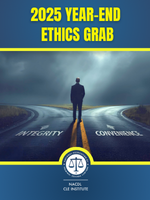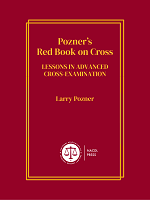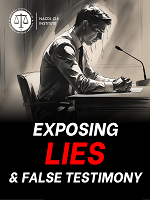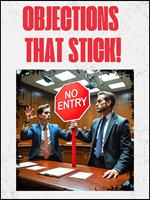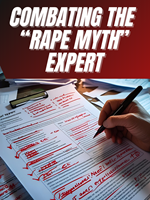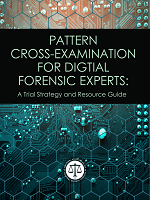Access to The Champion archive is one of many exclusive member benefits. It’s normally restricted to just NACDL members. However, this content, and others like it, is available to everyone in order to educate the public on why criminal justice reform is a necessity.
In 1992, Anthony Graves was convicted of capital murder and sentenced to death. Fourteen years later, a federal appeals court reversed Mr. Graves’ conviction, finding that prosecutor Charles Sebesta had withheld exculpatory evidence from the defense and allowed multiple witnesses to give false testimony.1 The Texas State Bar stripped Mr. Sebesta of his law license in 2015, but not soon enough to prevent Anthony Graves from serving 18 years in prison, 12 on death row.2 In Louisiana, John Thompson had his death warrant signed eight times. He narrowly escaped execution for carjacking and murder when a member of his defense team came across a microfiche containing the results of a blood test that proved his innocence.3 The test was never produced to the defense and the material containing the sample has never been found. Along with exculpatory testimony from an eyewitness that had been withheld by prosecutors, the evidence was able to free Mr. Thompson.4 Between 1973 and 2002, Orleans Parish sent 36 people to death row, nine of whom later had their convictions overturned due to Brady violations.5 None of the prosecutors in Mr. Thompson’s cases (he was tried twice) were ever disciplined, nor were any in the nine cases of the people who later had their convictions overturned.
From a blind symbol of Lady Justice to rhetoric that often describes an “adversarial” system, criminal justice in the United States is routinely presented as a balanced endeavor unfolding on a level playing field. Yet it is anything but. Only with recent egregious examples like those of Mr. Graves and Mr. Thompson, and high-profile misconduct like that in New Orleans, has the public begun to learn just how imbalanced the system can be. Study after study shows that prosecutorial misconduct is not an outlier. Prosecutors being held accountable for misconduct, however, are exceedingly rare. In 2013, ProPublica examined more than a decade’s worth of state and federal court rulings in New York City, finding more than two dozen incidences of judge-identified harmful misconduct.6 Of the prosecutors who oversaw cases that were reversed, only one faced discipline.7
It is within this climate of near-impunity that the criminal justice system extends prosecutors wide discretion in how to bring a case. Prosecutorial discretion gives prosecutors the authority to decide what charges to bring, bail recommendations, if diversion programs are offered and the terms of plea bargains, including plea charge and sentencing.8 With 97 percent of federal cases and 94 percent of state cases being resolved by pleas, prosecutors exercise control over the future of millions of the people who come into contact with the criminal justice system.9 In this way, prosecutors are the most powerful officials in the courtroom. It is thus important to subject their discretionary decisions to deeper analysis.
Prosecutorial discretion is not only dangerous because of the power prosecutors hold, but also because of the biases that can influence their decisions at every stage of a case. A study conducted by the Vera Institute of Justice found that prosecutors in the District Attorney’s Office of New York contributed to the large disparity in pretrial detention of misdemeanors, where blacks were 20 percent more likely than whites to be detained.10 The study also found that black and Latino people were more likely than similarly situated whites to receive a custodial sentence offer as a result of the plea bargaining process.11 Broader studies of urban courts have found even more stark disparities: black citizens were 66 percent more likely than whites to receive pretrial detention in felony cases and Hispanics were 91 percent more likely.12 Sadly, inequalities such as these are present at each stage of the justice system — stages where prosecutors command considerable authority to influence a case. The fact that these gaps persist suggests that prosecutors are unaware of the biases against certain demographics or the equally likely reality that they are unwilling to take proactive measures to address them.
Robert Smith, director of the Fair Punishment Project at Harvard Law School, examines this topic in The Impact of Implicit Racial Bias on the Exercise of Prosecutorial Discretion, discovering that key prosecutorial discretion points can be specifically influenced by implicit bias.13 Using empirical data from implicit association tests, he shows how the implicit association between black men and aggression provides an explanation for why prosecutors are less likely to charge white suspects than black subjects.14 Take the words of professor of law at American University and former director of the Public Defender Service for the District of Columbia, Angela J. Davis: “As the most powerful officials in the criminal justice system, [prosecutors’] discretionary decisions — especially their charging and plea-bargaining decisions — play a very significant role in creating and maintaining the racial disparities in the criminal justice system.”15
New research not only traces racial bias in courtrooms back hundreds of years, but highlights how bias is literally more than skin deep. In Looking Criminal and the Presumption of Dangerousness: Afrocentric Facial Features, Skin Tone, and Criminal Justice, U.S. District Court Judge Mark Bennett and Professor Victoria Plaut discuss historical preconceptions regarding skin tone across both Western and non-Western cultures.16 They also highlight how “Afrocentric features” beyond color (lips, nose, and hair, for example) also influence bias, with characteristics typically associated with blacks correlating to the length of sentences.17 While children as young as three months have been observed to exhibit preferences for faces that match their own race, studies also show that they are influenced by their environment and the races they observe.18 Other studies have shown that everyday behavior in adolescence — from a bump in the hallway to using another’s pencil without first asking — can be perceived as more aggressive if observed from a black student as opposed to a white student.19 Later in life, black men are perceived as larger in physical size and more muscular, therefore more physically threatening.20 In the context of law enforcement, this false perception manifests itself in the evaluating of imminent danger and justifying the use of force.21
In the courtroom, it is manifested in unbalanced outcomes. The bench appears to be taking notice. The American Bar Association, district court judges, and even Supreme Court justices have begun taking actions to counteract implicit bias in the courtroom.22 But rather than prosecutors serving as a further backstop against prejudice seeping into the system or countering it through their discretionary decisions, some suggest they are exacerbating disparities. One such study, by Professor John Pfaff of Fordham Law School, lays the blame for the boom in prison population in part at the feet of prosecutors. Pfaff found that between 1994 and the late 2000s, prosecutors changed how they charged misdemeanor cases.23 In 1994, one out of every three arrests was charged as a felony. In the late 2000s, however, that number had risen to two out of every three arrests.24 The decision to pursue a felony above a misdemeanor conviction carries with it significant implications for prison time.
Given that every state — except Alaska, Connecticut and New Jersey — elects its prosecutors, it would be easy to assume that a candidate’s conviction rate or tough-on-crime reputation motivates his or her behavior. David Schleicher of Yale Law School, however, found that this assumption is unlikely given the low turnout and general voter disinterest in contests lower on the ballot.25 Additionally, reviews show that upwards of 80 percent of prosecutors run unopposed.26
Are tougher laws to blame? Probably not. Research suggests that during the first 15 years of the rapid growth in prison population (1970-1985), there “was an absence of significant change in penal legislation.”27 Where physical constraints in the number of prisons and their capacity would be expected to play a limiting role, states constructed new prisons and modified facilities.28 A more likely explanation for this expansion has been suggested in the disconnect between the discretion to charge (made at the local level) and the cost of incarceration (borne by the state). Franklin Zimring and Gordon Hawkins coined the term “correctional free lunch” when describing this incentive scheme that detaches the decision to incarcerate from the cost to incarcerate.29
While economics and the cost of incarceration should have nothing to do with the fair administration of justice, some states have begun looking at the financial incentives related to charges, plea bargaining and incarceration. In 2011, California instituted an effort to “realign” the state’s burden by shifting some of the lower-level inmate population back to local county jails — along with the cost — among other reforms.30 Tellingly, local prosecutors became less enthusiastic in seeking charges that, if resulting in conviction, would result in an inmate that would be a financial liability against the local budget.31 While California might be the best-case scenario for reform, South Dakota might be the worst. The 2013 Public Safety Improvement Act in South Dakota bolstered probation and parole, diversion options and treatment programs, and reduced South Dakota’s overall prison population by eight percent by 2015.32 An unforeseen consequence, however, was that prosecutors reacted through charging mechanisms: felony convictions over that same period rose 26 percent, which re-aligned costs at the state level.33
Despite these mixed results, however, states should continue to analyze ways to incentivize localities to set smarter, more efficient charging priorities. Proposals include block grants paid by states to counties based on local crime rates. Done in conjunction with reduced state funding of prisons, this method would allow local officials to tailor their criminal justice spending to specific needs. The cost of incarceration over and above what the crime rate data suggests for a local municipality would be shifted back to the local level.34 Another proposal further uncouples states from prisons by decentralizing the administration of corrections and passes it to smaller, more local units. This “unification” of both charging and incarcerating would require localities to consider the full cost of prosecution.35
Above and beyond incarceration rates and misaligned costs, the most alarming figure about race and prosecution is that it is a very, very one-sided endeavor. As recently as 2015, 95 percentof prosecutors in the United States were white.36 In a climate where the aforementioned racial biases about aggression, dangerousness and criminality can begin in childhood, those elected (often unopposed) to use their discretion to enforce our laws frequently look different than those who are being charged. Add to that an unwillingness to hold bad prosecutors accountable and an inability to properly align the incentives of incarceration, and the justice system is primed to reinforce and repeat racial disparities against people of color.
What can be done? A few recent examples highlight the impact of citizen activism when district attorney elections are no longer foregone conclusions. In Cleveland and Chicago, public outcry at the deaths of Tamir Rice and Laquan McDonald — and the appearance of the prosecutor’s offices dragging their feet in holding law enforcement accountable — led to public campaigns successfully challenging the re-election of the district attorneys.37 With respect to policy, prosecutor offices can follow the lead of the Department of Justice in mandating implicit bias training.38 In Philadelphia, new District Attorney Larry Krasner quickly moved to change the tone of the corruption by his predecessor, Seth Williams, by setting new policies of not seeking the death penalty, ending civil asset forfeiture without conviction, and reforming cash bail.39
As mentioned, some courts have taken the initiative to educate potential jurors about implicit bias. While an imperfect solution for countering bias brought into charging decisions, states and localities should embrace the training of potential jury members. While the results have been mixed in efforts to more closely align the financial incentives of prosecutors, realignment legislation that imposes costs on localities that aggressively upcharge should be analyzed and implemented. Finally, close and continued studies of the impact of law enforcement, charging, offering pleas, and prosecuting must quickly identify and correct racial disparities. In a twist of irony, if we aspire to a justice system that is blind, we must see the role of race for what it really is.
Notes
- DA Disbarred for Sending Texas Man to Death Row, CBS News, June 12, 2015, http://www.cbsnews.com/news/charles-sebasta-prosecutor-of-wrongfully-convicted-man-anthony-graves-loses-law-license/.
- Id.
- Radley Balko, The Untouchables: America’s Misbehaving Prosecutors, and the System That Protects Them, Huffington Post, Aug. 1, 2013, http://www.huffingtonpost.com/2013/08/01/prosecutorial-misconduct-new-orleans-louisiana_n_3529891.html.
- Id.
- Id.
- Joaquin Sapien & Sergio Hernandez, Who Polices Prosecutors Who Abuse Their Authority? Usually Nobody, ProPublica, Apr. 3, 2013, https://www.propublica.org/article/who-polices-prosecutors-who-abuse-their-authority-usually-nobody.
- Id.
- Emily Graham, Racial Bias and Prosecutorial Discretion, Harv. L. Sch. Chapter Am. Const. Soc’y, Feb. 8, 2016, https://orgs.law.harvard.edu/acs/2016/02/08/racial-bias-and-prosecutorial-discretion/#_ftnref6.
- Erica Goode, Stronger Hand for Judges in the ‘Bazaar’ of Plea Deals, N.Y. Times, Mar. 22, 2012, http://www.nytimes.com/2012/03/23/us/stronger-hand-for-judges-after-rulings-on-plea-deals.html.
- Besiki Kutateladze, Whitney Tymas & Mary Crowley, Vera Institute of Justice, Race and Prosecution in Manhattan, July 8, 2014, https://www.vera.org/publications/race-and-prosecution-in-manhattan.
- Id.
- Stephen Demuth, Racial and Ethnic Differences in Pretrial Release Decisions and Outcomes: A Comparison of Hispanic, Black, and White Felony Arrestees, 41 Criminology 873, 895 (2003).
- Robert J. Smith, The Impact of Implicit Bias on the Exercise of Prosecutorial Discretion, 35 Seattle U. L. Rev. 795 (2012), https://papers.ssrn.com/sol3/papers.cfm?abstract_id=2045316.
- Id.
- Angela J. Davis, In Search of Racial Justice: The Role of the Prosecutor, 16 N.Y.U. J. Legis. & Pub. Pol’y 821 (2014), http://www.nyujlpp.org/wp-content/uploads/2014/01/Davis-In-Search-of-Racial-Justice-16nyujlpp821.pdf.
- Mark Bennett & Victoria Plaut, Looking Criminal and the Presumption of Dangerousness: Afrocentric Facial Features, Skin Tone, and Criminal Justice, 51 U.C. Davis L. Rev. (forthcoming 2018); see also Amanda Mae Petersen, Beyond Black and White: An Examination of Afrocentric Facial Features and Sex in Criminal Sentencing (June 25, 2014) (unpublished master’s thesis, Portland State University), https://pdxscholar.library.pdx.edu/open_access_etds/1855.
- Id.
- Y. Bar-Haim et al., Nature and Nurture in Own-Race Face Processing, 17 Psychol. Sci. 2 (2006).
- H. Andrew Sagar & Janet Schofield, Racial and Behavioral Cues in Black and White Children’s Perceptions of Ambiguously Aggressive Acts, 39 J. Personality & Soc. Psychol. 590, 593, (1980), https://pdfs.semanticscholar.org/e34e/3023d044fd9391112ebdf65444d004c2200f.pdf.
- John Paul Wilson et al., Racial Bias in Judgments of Physical Size and Formidability: From Size to Threat, 113 J. Personality & Soc. Psychol. 59, 59 (2017).
- Id.
- See https://www.americanbar.org/publications/youraba/2016/september-2016/strategies-on-implicit-bias-and-de-biasing-for-judges-and-lawyer.html; see also Marella Gayla, A Federal Court Asks Jurors to Confront Their Hidden Biases, The Marshall Project, June 21, 2017, https://www.themarshallproject.org/2017/06/21/a-federal-court-asks-jurors-to-confront-their-hidden-biases; see also Mark Bennett, The Implicit Racial Bias in Sentencing: The Next Frontier, 126 Yale L.J.F., 381 (2017), https://www.yalelawjournal.org/forum/the-implicit-racial-bias-in-sentencing.
- Juleyka Lantigua-Williams, Are Prosecutors the Key to Justice Reform? The Atlantic, May 18, 2016, https://www.theatlantic.com/politics/archive/2016/05/are-prosecutors-the-key-to-justice-reform/483252/.
- Id.
- Id.
- ACLU, Roadblocks to Reform: District Attorneys, Elections, and the Criminal Justice Status Quo, ACLU of Oregon, 2016, https://aclu-or.org/sites/default/files/Roadblocks_to_Reform_Report_ACLUOR.pdf.
- Franklin Zimring, The Scale of Imprisonment in the United States: Twentieth Century Patterns and Twenty-First Century Prospects, 100 J. Crim. L. & Criminology 1225 (2010), https://scholarlycommons.law.northwestern.edu/cgi/viewcontent.cgi?referer=https://www.google.com/&httpsredir=1&article=7374&context=jclc.
- Id.
- Franklin Zimring & Gordon Hawkins, The Scale of Imprisonment (1993).
- Magnus Lofstrom & Brandon Martin, Public Safety Realignment: Impacts So Far, Pub. Pol’y Inst. Cal. (Sept. 2015), http://www.ppic.org/publication/public-safety-realignment-impacts-so-far/.
- Supra note 23.
- Brian Elderbroom et al., Assessing the Impact of South Dakota’s Sentencing Reforms: Justice Reinvestment Initiative, Urb. Inst., May 5, 2016, https://www.urban.org/research/publication/assessing-impact-south-dakotas-sentencing-reforms-justice-reinvestment-initiative.
- Id.
- W. David Ball, Defunding State Prisons, Santa Clara Law Digital Commons, 2013, http://digitalcommons.law.scu.edu/cgi/viewcontent.cgi?article=1606&context=facpubs.
- Id.
- Reflective Democracy Campaign, Justice for All? 2015, http://wholeads.us/justice/wp-content/themes/phase2/pdf/key-findings.pdf.
- Richard Pérez-Peña, Angered by Cities’ Handling of Police Shootings, Voters Oust Two Prosecutors, N.Y. Times, Mar. 16, 2016, https://www.nytimes.com/2016/03/17/us/angered-by-cities-handling-of-police-shootings-voters-oust-two-prosecutors.html.
- Press Release, Department of Justice, Department of Justice Announces New Department-Wide Implicit Bias Training for Personnel (June 27, 2016), https://www.justice.gov/opa/pr/department-justice-announces-new-department-wide-implicit-bias-training-personnel.
- Dann Cuellar, Days After Shakeup New Philadelphia District Attorney Larry Krasner Outlines His Plan, 6 ABC Action News, Jan. 10, 2018, http://6abc.com/politics/days-after-shakeup-new-philadelphia-da-outlines-his-plan/2920192/.
About the Author
Rick Jones is the executive director and a founding member of the Neighborhood Defender Service of Harlem, which has gained national and international recognition for its early-entry, holistic, client-centered, community-based, team-defense approach to public defense. He teaches the criminal defense externship and a trial practice course at Columbia Law School, serves on the faculty of the National Criminal Defense College in Macon, Georgia, and is a member of the board of the International Legal Foundation.
Rick Jones
Neighborhood Defender Service of Harlem
New York, NY
212-876-5500
www.ndsny.org
rjones@ndsny.org



